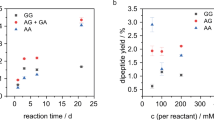Summary
The condensation of glycine to form oligoglycines during wet-dry fluctuations on clay surfaces was enhanced up to threefold or greater by small amounts of histidyl-histidine. In addition, higher relative yields of the longer oligomers were produced. Other specific dipeptides tested gave no enhancement, and imidazole, histidine, and N-acetylhistidine gave only slight enhancements. Histidyl-histidine apparently acts as a true catalyst (in the sense of repeatedly catalyzing the reaction), since up to 52 nmol of additional glycine were incorporated into oligoglycine for each nmol of catalyst added. This is the first known instance of a peptide or similar molecule demonstrating a catalytic turnover number greater than unity in a prebiotic oligomer synthesis reaction, and suggests that histidyl-histidine is a model for a primitive prebiotic protoenzyme. Catalysis of peptide bond synthesis by a molecule which is itself a peptide implies that related systems may be capable of exhibiting autocatalytic growth.
Similar content being viewed by others
References
Bender ML, Brubacher LJ (1973) Catalysis and enzyme action. McGraw-Hill, New York
Beyerman HC, Maassen van den Brink W (1966). In: Zervas L (ed) Peptides, Pergamon Press, London, p 85
Callahan PX, Shepard JA, Reilly TJ, McDonald JK, Ellis S (1970) Anal Biochem 38:330–356
Clark GL (ed) (1966) The encyclopedia of chemistry, 2nd ed. New York, p 187
Dose, K (1971) In: Schwartz, AW (ed) Theory and experiment in exobiology, vol I. Wolters-Noordhoff, Groningen, p 42
Ehler KW, Orgel LE (1976) Biochim Biophys Acta 434:233–243
Frost AA, Pearson RG (1961) Kinetics and mechanism, 2nd ed. Wiley, New York, p 200
Hawley GG (ed) (1977) The condensed chemical dictionary, 9th ed. Van Nostrand, New York, p 171
Ibanez JD, Kimball AP, Oró J (1971a) J Mol Evol 1:12–114
Ibanez J, Kimball AP, Oró J (1971b) In: Buvet R, Ponnamperuma C (eds) Chemical evolution and the origin of life. North-Holland, Amsterdam, p 171
Jungck JR, Fox SW (1973) Naturwissenschaften 60:425–487
Kapoor A (1972) In: Lande S (ed) Progress in peptide research II. Gordon and Breach, New York, p 335
Kenyon DH, Steinman G (1969) Biochemical predestination. McGraw-Hill, New York, p 211
Lahav N, Chang S (1976) J Mol Evol 8:57–380
Lahav N, White DH, Chang S (1978) Science 201:6–69
Lohrmann R, Orgel LE (1973) Nature 244:418–420
Martin EA (ed) (1976) A dictionary of life sciences. MacMillan Press, London, p 52
Paecht-Horowitz M (1976) Origins Life 7:369–381
Pattee HH (1965) Adv Enzymol 27:381–415
Photaki I, Sakarellou-Daitsiotou M (1976) J Chem Soc Perkin I:589–591
Pongs O, Ts'o POP (1969) Biochem Biophys Res Commun 36:475–481
Renz M, Lohrmann R, Orgel LE (1971) Biochim Biophys Acta 240:475–481
Rideal EK (1968) Concepts in catalysis. Academic Press, New York, p 4
Sawai H, Lohrmann R, Orgel LE (1975) J Mol Evol 6:165–184
Stenesh J, (ed) (1975) Dictionary of biochemistry. Wiley, New York, p 44
Stephen-Sherwood E, Odom DG, Oró J (1974) J Mol Evol 3:323–330
Stillwell W, Steinman G, McCarl RL (1972) Bioorg Chem 2:1–10
Verlander MS, Lohrmann R, Orgel LE (1973) J Mol Evol 2:303–316
Weber AL, Lacey JC Jr(1974) Biochim Biophys Acta 349:226–234
Weber AL, Lacey JC Jr (1975) J Mol Evol 6:309–320
Weber AL, Orgel LE (1978) J Mol Evol 11:9–16
Weber AL, Caroon JM, Warden JT, Lemmon RM, Calvin M (1977) Biosystems 8:277–286
White DH (1980) J Mol Evol 16:121–147
White DH, Erickson JC (1980) J Mol Evol, in press
Williams RJ, Lansford EM Jr. (eds) (1977) The encyclopedia of biochemistry, Krieger Huntington NY, p 205
Author information
Authors and Affiliations
Rights and permissions
About this article
Cite this article
White, D.H., Erickson, J.C. Catalysis of peptide bond formation by histidyl-histidine in a fluctuating clay environment. J Mol Evol 16, 279–290 (1980). https://doi.org/10.1007/BF01804979
Received:
Revised:
Issue Date:
DOI: https://doi.org/10.1007/BF01804979




